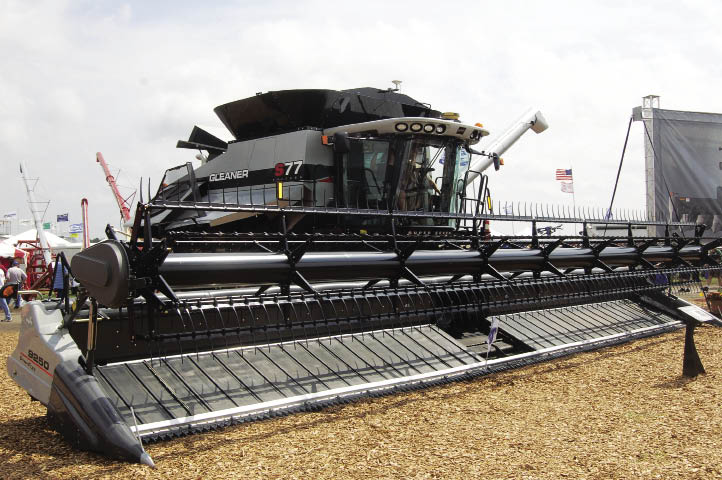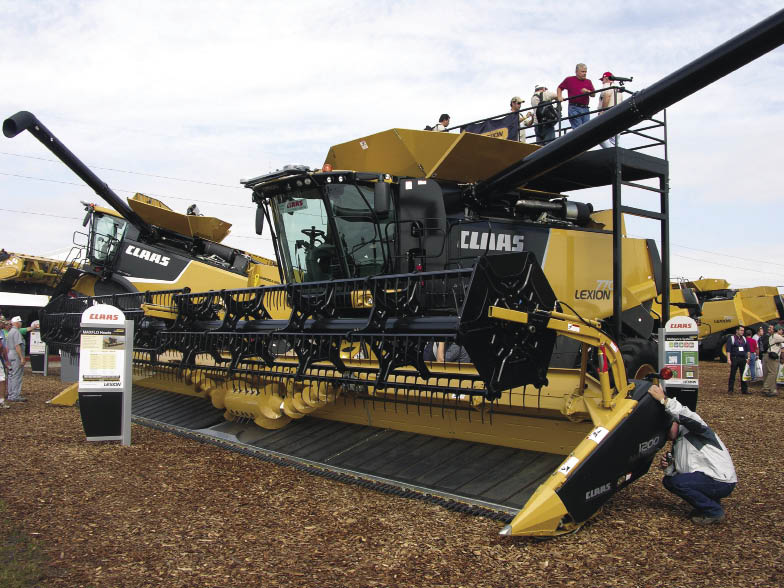Virtually all combine and corn head exhibitors echoed the same sentiment when it came to trends in harvesting equipment. Shorter harvesting windows due to inclement weather, increased grain throughput demands, the need for speed, and ever-larger heads and combines to handle larger acreages continue to drive new harvesting development. All this, plus the need to control compaction with the combine, grain cart and semi-truck at the same time were emphasized in the new equipment this year.
CASE IH highlighted its Axial-Flow 9120, the company’s first and industry’s largest Class 9 combine. At 423 hp and 350-bu. tank capacity, harvesting specialist Dan Klein noted that it’s the highest horsepower and largest grain capacity combine in North America, and included enhancements identified through the customer-driven design process. The company also introduced its new 3020 flex head to capture more grain in less field time.
 AGCO’s Chuck Schrader highlighted the Gleaner S7 Series Transverse Rotor Combine, which he says is the lightest Class 7 combine on the market. “We satisfied the demand for more capacity without sacrificing core design,” he says. “We didn’t have to go to higher weights to accomplish it. We added less than 1,000 lb., and this is the only one on the market that is under 30,000 lb.” Key among the design enhancements, he says, are the increased rotor size, and larger accelerator rolls and cooling fan for greater air volume. AGCO also displayed its DynaFlex, that it says is the lightest 40-ft. draper header on the market.
AGCO’s Chuck Schrader highlighted the Gleaner S7 Series Transverse Rotor Combine, which he says is the lightest Class 7 combine on the market. “We satisfied the demand for more capacity without sacrificing core design,” he says. “We didn’t have to go to higher weights to accomplish it. We added less than 1,000 lb., and this is the only one on the market that is under 30,000 lb.” Key among the design enhancements, he says, are the increased rotor size, and larger accelerator rolls and cooling fan for greater air volume. AGCO also displayed its DynaFlex, that it says is the lightest 40-ft. draper header on the market.
 CLAAS launched its 770 (523 hp) Class 10 combines at Farm Progress. According to Jeff Gray, senior product specialist, the real advantage is the combination of the Accelerated Pre-Separation threshing system with the Roto Plus separation. Together these provide the greatest separation capacity of any combine in the industry, says Gray.
CLAAS launched its 770 (523 hp) Class 10 combines at Farm Progress. According to Jeff Gray, senior product specialist, the real advantage is the combination of the Accelerated Pre-Separation threshing system with the Roto Plus separation. Together these provide the greatest separation capacity of any combine in the industry, says Gray.
Its Terra Trac track system “smiles” and “frowns” with the contour of the ground as a result of the integrated intelligent track system that provides full independent suspension. It reduces shocks to the operator and combine and far less soil compaction than other, smaller combines, Gray says.
Corn head manufacturers also demonstrated that there’s a definite trend toward more aggressive chopping action. DRAGOTEC, which has 20% market share of corn headers, has created several options for growers of different residue management needs. Joe Bollig cited the Turbo Chop, which it introduced recently and has been effective in northern regions where there’s less time for stalk decomposition. The firm’s options include stationary knife, knife roll, flail chopper and turbo-chop.
CALMER CORN HEADS continues to see wide interest in its BT Crusher. Next, the firm is working on a new stalk roll and BT Chopper to satisfy growers who want a more aggressive chop in corn-on-corn. This unit, says Marion Calmer, will feature self-sharpening tungsten carbide knives and give more chopping action without having to make a major investment. Calmer added that a longer and taller row unit is allowing the combine to get the plant down with less trash in the combine for great overall efficiency.
MUDHOG-TUTHILL unveiled its Bale Direct System. Darren Foster says the novel system allows farmers to harvest and bale in one pass to save time, fuel and labor. The system connects a large square baler to the combine and passes the material on an enclosed conveyor that prevents spillage.
HILLCO TECHNOLOGIES, in partnership with John Deere, introduced its new cob collection system, an attachment designed specifically for Deere’s STS combines. The cob collector is another entry into equipment being developed to utilize sustainable biomass feedstocks for the renewable fuels industry.
According to Lenny Hill, president of Hillco, the cob collector utilizes innovative single-pass collection technology that maximizes cob cleaning and collection capabilities with minimal impact on harvesting speed and efficiency. The system also provides the flexibility to use either a combine-pulled cart or a tractor-pulled cart, depending on the farming operation and field conditions. The “Spread to Collect” mode allows farmers to select the areas of the field to be collected, and is easily switched for harvesting soybeans.
>> Click here to read the rest of FE's 2010 Farm Progress report





